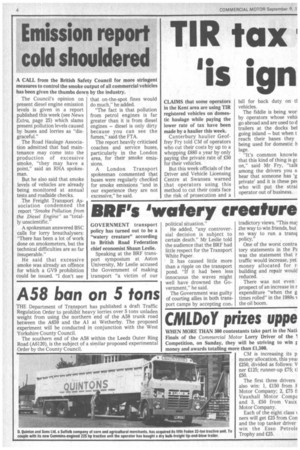Emission report cold shouldered
Page 6

If you've noticed an error in this article please click here to report it so we can fix it.
A CALL from the British Safety Council for more stringent measures to control the smoke output of all commercial vehicles has been given the thumbs down by the industry.
The Council's opinion on present diesel engine emission levels is given in a report published this week (see News Extra, page 25) which slams present pollution levels caused by buses and lorries as "disgraceful."
The Road Haulage Association admitted that bad maintenance may come into the production of excessive smoke, "they may have a point," said an RHA spokesman.
But he also said that smoke levels of vehicles are already being monitored at annual tests and roaaside checks.
The Freight Transport Association condemned the report "Smoke Pollution from the Diesel Engine" as "totally unscientific."
A spokesman answered BSC calls for lorry breathalysers: "There has been a lot of work done on smokemeters, but the technical difficulties are so far insuperable."
He said that excessive smoke was already an offence for which a GV9 prohibition could be issued. "I don't see. that on-the-spot fines would do much," he added.
"The fact is that pollution from petrol engines is far greater than it is from diesel engines — diesel is only dirty because you can see the fumes," said the FTA.
The report heavily criticised coaches and service buses, particularly in the London area, for their smoke emissions.
A London Transport spokesman commented that buses were regularly checked for smoke emissions "and in our experience they are not excessive," he said.
















































































































